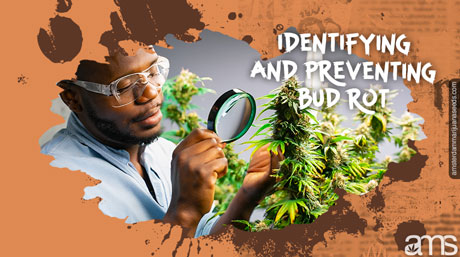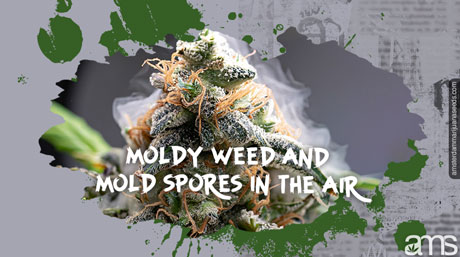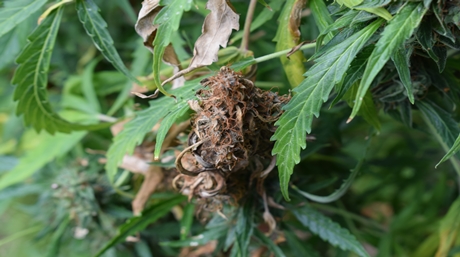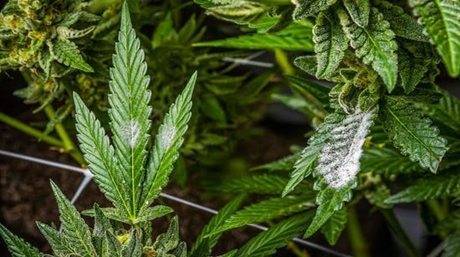Growing cannabis, especially indoors, is a beautiful yet delicate art. It requires diligence, attentiveness, and a genuine connection with your plants. One of the most common threats indoor cannabis cultivators face is bud rot, a fungal disease that can be a catastrophe if not addressed swiftly and correctly.
Let’s begin with understanding what bud rot is and how to spot it.
Botrytis cinerea, commonly known as bud rot, is a fungal pathogen that takes root inside the dense buds of cannabis plants, often going unnoticed until significant damage has been done. This sly attacker turns your luscious green buds into a moldy mess. If you notice any discoloration, typically grey or brown, on your buds, or if they crumble easily when handled, you’re likely dealing with bud rot.
It’s important to note that there are other mold types you may encounter in your indoor grow room. White Powdery Mildew and Fuzzy White Mold (Regular Mold) are also common and can leave a powdery white residue on the leaves and buds. All mold types are hazardous to both your plants and your health. Never smoke moldy buds! Smoking moldy weed can lead to respiratory distress and severe allergic reactions.

As the old saying goes, “Prevention is better than cure,” and this holds particularly true when it comes to bud rot. Here are a few essential strategies you can employ to protect your plants:
Addressing Bud Rot and Mold Infestation
Despite your best efforts, there may be occasions where you’ll encounter bud rot or other types of mold in your grow room. It’s essential to act quickly to prevent further damage to your plants.
As soon as you identify mold or bud rot, isolate the affected plant to prevent the spread of spores to healthy plants. Safely dispose of the affected parts and thoroughly clean your grow room. Remember, cleanliness is crucial to limiting mold spores.
Next, rectify the environmental conditions that led to the outbreak. High humidity, poor ventilation, and overcrowding are common factors. Making necessary adjustments in these areas reduces the risk of a recurring issue.

Growing mold in your cannabis grow room is a formidable enemy. It can thrive in conditions that are typically great for your plants—warm, humid, and slightly acidic environments. Thus, it’s essential to have an arsenal of remedies at hand to eliminate any invading mold.
A variety of organic solutions exist to combat mold. One such solution is a mixture of water and hydrogen peroxide. Hydrogen peroxide, H2O2, is chemically similar to water but contains an extra oxygen atom that makes it lethal to fungi. It’s often used in a 3% solution (available in most pharmacies), mixed with two parts water. This mixture can be lightly misted onto the affected areas, providing an immediate mold-killing effect. However, it’s essential to use this solution with care as hydrogen peroxide can damage your plant’s cells if overused. For best results, apply the mixture early in the day so that the extra moisture has ample time to evaporate before the lights go off.
Neem oil is another excellent organic option to fight mold. Derived from the fruits and seeds of the Neem tree, this oil is revered for its fungicidal properties. Neem oil works by altering the plant’s cell wall, eventually causing the fungal cells to collapse. When mixed with a little dish soap and water, it can be sprayed directly onto the affected areas of your plants. However, like hydrogen peroxide, it’s essential to apply this solution with caution, especially under strong lights, as the oil can potentially cause the plant to burn.
Bacillus subtilis, a type of bacteria naturally occurring in the soil, serves as an efficient organic fungicide. This beneficial bacterium takes up residence on the plant, forming a barrier against destructive mold spores. Ask at your local garden store for a product that contains this bacteria and can be applied as a preventative treatment.
In addition to these solutions, commercial fungicides can be an effective tool against mold. These products often contain sulfur or copper, which are toxic to fungi. However, these should be used as a last resort and always with careful attention to the instructions, as they can be harmful to both the user and the environment if used incorrectly.
Lastly, remember to ensure proper safety when using these products. Always use gloves and protective clothing, and avoid getting these substances in your eyes or mouth.
Mold spores are ubiquitous in the environment. They can find their way into your grow room through air, water, soil, or even on your clothes. Maintaining a clean and well-ventilated grow room can help manage the number of spores present.
An air purifier can also assist in capturing airborne spores. HEPA filters are excellent for this task, as they can filter out the majority of mold spores. Regularly changing these filters is necessary for their effectiveness. (HEPA stands for High-Efficiency Particulate Absorbing filter and is also referred to as a High-Efficiency Particulate Arrestance filter)

The flowering stage is when your plants are most susceptible to mold. Increased humidity and thicker plant growth can lead to a higher chance of mold development. It’s vital to monitor humidity levels closely, increase ventilation, and perform regular inspections during this stage.
We’ve journeyed through the world of indoor cannabis cultivation and the crucial challenge posed by molds, particularly bud rot. These stealthy invaders may seem intimidating, but armed with knowledge, you can wage an effective battle against them.
Identification is the first crucial step in this journey. A keen eye for the tell-tale signs of mold, such as discolored or wilting leaves and buds, can be your best line of defense. Tools like a jeweler’s loupe or a microscope will be essential companions, helping you spot the first signs of trouble before it escalates.
Next is prevention, a comprehensive approach that encompasses several aspects of indoor cannabis cultivation. It starts with maintaining an ideal environment in your grow room, with optimal humidity levels and air circulation. Regular pruning and shaking off excess moisture from your plants is also crucial. Remember, prevention is easier than cure, and consistent preventive measures will save you a lot of time, energy, and resources in the long run.
However, should the need arise, swift and effective elimination is key. From organic solutions like hydrogen peroxide and Neem oil to commercial fungicides, a variety of tools are at your disposal to tackle an active mold infestation. Timely action is the most critical factor here; mold spreads quickly and can devastate an entire crop if left unchecked.
Keep in mind that the entire process requires constant vigilance and daily attention to your plants. It may seem demanding, but the reward at the end of this laborious process is well worth it. Imagine the satisfaction of holding in your hands a yield of healthy, high-quality, and safe-to-consume cannabis. Each bud is a testament to your dedication and passion for cultivation.
Cultivating cannabis is more than just a process; it’s an art, a science, and a labor of love. As we always say, it’s not just about the destination (although a successful harvest is indeed gratifying), it’s also about the journey. Enjoy every moment of it, from the first sprout of your seedlings to the curing of your buds. Through trials and triumphs, you’ll grow and learn along with your plants, creating an enriching and fulfilling experience.
In conclusion, don’t let the fear of mold deter you. With knowledge, awareness, and appropriate measures, you can tackle this issue head-on, ensuring a healthy and productive cannabis grow.
Happy growing, and here’s to your future success in indoor cannabis cultivation!
Bud rot, also known as Botrytis cinerea, is a fungal pathogen that affects cannabis plants. It can be identified by discoloration, typically grey or brown, on the buds, as well as buds that crumble easily. If you notice these signs, you're likely dealing with bud rot.
There are several strategies you can employ to prevent bud rot indoors, including maintaining air circulation, keeping excess moisture in check, controlling humidity levels, regular pruning, and conducting regular inspections. These measures help create an environment less conducive to mold growth.
If you encounter bud rot or mold infestation, it's important to act quickly to prevent further damage. Isolate the affected plant, dispose of the affected parts, and thoroughly clean your grow room. You can also use organic solutions like hydrogen peroxide, Neem oil, or commercial fungicides to eliminate the mold. Proper safety precautions should be followed when using these products.













Related Posts

By now I m sure you have become an expert at checking your leaves and wiping them down with a mixture of apple cider vinegar at the first sign of a spore.

Bud rot affects the buds of the cannabis plant. Read this article to know how to protect your cannabis plants against it.